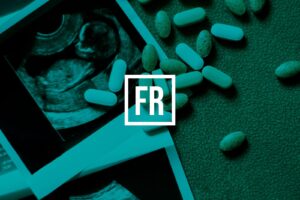Whilst around one in six heterosexual couples fail to conceive after 12 months of regular intercourse (the medical definition of infertility), around half will go on to conceive without treatment in the second year of trying.
Fertility testing and the three aspects of conception
To assess whether continuing trying naturally or moving on to treatment is the best option it’s important to arrange for the right fertility testing at the right time. Tests are focused on the three aspects of conception – (1) motile sperm meeting an (2) egg in a (3) patent Fallopian tube. Therefore, tests include a semen analysis (the presence of motile sperm), confirmation of ovulation (is an egg being produced and released), and tubal patency testing (can the egg and sperm meet) by HyCoSy scan, hysterosalpingogram (HSG) or laparoscopy and dye operation. Usually, these tests are performed after 12 months of trying, but if a woman is beyond her mid-30s, her periods are irregular or absent (suggestive of lack of ovulation), there are symptoms increasing the likelihood of pelvic pathology (e.g., previous surgery, known or possible endometriosis or ovarian cysts, a history of Chlamydia), or a man has had testicular surgery or trauma, or was born with undescended testes, then investigation after only 6 months is appropriate. Tests reveal no abnormalities in around a third of patients (unexplained infertility), primarily female in a third, and primarily male in a third. Sometimes there will be issues on both the male and female sides. The rest of this article focuses on what to do when male fertility problems have been identified.
Three most important aspects of semen analysis
The three most important aspects of the semen analysis are the count (should be >15 million/ml), the volume of the sample (>=1.5ml) and the motility (total percentage swimming forward (‘progressively motile’) >=30%). There are many other variables checked in a sperm test that may have minimal effect on the chance of success, for example, the percentage of normal forms (morphology).
Dealing with sperm abnormalities
If an abnormality is found then the treatment plan depends on the severity of the result. If there are no sperm (azoospermia) or a very low count or motility, then the test should be repeated around 3 months later. Severe flu or other illness can temporarily affect sperm and the production cycle, around 10 weeks, needs to be given a chance. If there is again a lack of sperm then a testicular examination to confirm that the tubes draining the testes are present plus (1) genetic blood tests for karyotype (checking the number of chromosomes) and cystic fibrosis, plus (2) hormone tests are required. Depending on the results it is often possible to find sperm at a Surgical Sperm Retrieval (SSR). This sperm is used during IVF-ICSI treatment.
Male lifestyle factors
When a semen analysis returns with an abnormal result it is always worth looking at lifestyle factors. It is recognised that obesity, smoking and excessive alcohol can negatively affect sperm quality and conception rates in ways we do not fully understand. Illicit drugs, steroids for bodybuilding, and some prescribed drugs can also reduce male fertility. For all patients trying to conceive it is worth optimising these factors, particularly when an abnormality has been found. In my opinion, there is no good evidence that one type of diet is better than another but reducing the amount of processed food makes sense. A popular obstetrics textbook from when I was a student (long ago!) said that pregnant women should eat food bought from the greengrocer, the butcher, and the fishmonger. Whilst few such places now exist on the High Street the sentiment is the same, eat more freshly cooked and less processed food to optimise reproductive health. In my opinion, there is no good evidence that routine vitamin supplementation for men improves fertility. However, it is very unlikely vitamins will do harm and there is always the possibility of a benefit. I suggest buying supplements specially formulated for men from a Chemist or specialist drug company online, rather than buying high doses of individual vitamins.
Moving on to treatment
Moving on to treatment, there are relatively few men that will benefit from prescribed drugs to improve sperm. If a man has azoospermia (no sperm) and a blood test shows a lack of hormones driving sperm production, then hormone injections three times a week can lead to good levels of sperm. However, this is an uncommon cause of infertility. Sometimes men will be given drugs such as clomifene (usually used for women to treat ovulation) though the evidence for improved sperm production is currently unclear.
IUI
Intra-uterine insemination (IUI) was widely used for couples with mild to moderate male factor infertility. IUI involves concentrating a sperm sample and injecting it into the uterine cavity via the cervix at the time of ovulation. The 2013 NICE Fertility Guidelines reported that IUI for couples with male factor infertility was no more successful than trying naturally, and so IUI is now an uncommon treatment in the UK, apart from when donor sperm is used (when it can be very successful).
The main treatment for male factor infertility: IVF with ICSI
The main treatment for couples with male factor infertility is IVF usually with ICSI. The NICE Guidelines suggest that IVF is the most appropriate treatment for couples who have been trying unsuccessfully to conceive naturally for two years, whatever the cause of the fertility problem. This is why most NHS CCGs (clinical commissioning groups) use two years as a funding criterion. However, when there is azoospermia then, if sperm is found at SSR, moving straight to IVF with no delay is appropriate. When there is severe male factor infertility, but some sperm are present, the chance of natural conception may be very low but the CCGs still usually insist on a two year wait. Some couples may therefore go the self-funded route instead.
What IVF involves
IVF involves the woman having around 10-14 days of hormone injections to stimulate the ovaries. This is followed by an egg collection. If sperm quality is normal then conventional IVF (cIVF) is used, with around 100,000 motile sperm being mixed with each egg. If there is a male factor, then ICSI for insemination in which a single sperm is selected by the embryologist and injected into each egg is normally used. The fertilisation rate of ICSI when using reduced quality sperm is equivalent to that of cIVF when normal quality sperm is used, i.e., around 65%. ICSI is therefore an excellent treatment for male factor infertility. Fertilised eggs, called embryos, are then incubated for five days to the blastocyst stage when one or two, depending on female age, are transferred to the uterine cavity. The success rate of IVF +/- ICSI depends mainly on the woman’s age, the quality of sperm has little effect since ICSI is available. Women in their mid-30s or below should have a livebirth rate per IVF cycle of around 40%. If donor sperm is used because a man has azoospermia and no sperm is found on SSR, or if a single woman or same-sex female couple are undergoing treatment, then ICSI may be used if the sperm quality is variable.
What ICSI involves
For ICSI the embryologist looks down a microscope for motile sperm of a normal shape (morphology) to select for insemination. There are additional techniques that can be used for sperm selection beyond this, including IMSI and PICSI. The theory is that these help improve success rates though evidence doesn’t support their routine use. Some clinics suggest that men have a Sperm DNA Fragmentation test to assess sperm functionality beyond the standard measurements described above. Again, good data confirming the benefits of fragmentation testing are awaited but it may be of value in selected cases. If fragmentation levels are raised then optimising lifestyle factors, improving diet, taking anti-oxidant supplements and using sperm selection techniques such as ICSI, PICSI or IMSI are often recommended though proven benefits are again unclear. The HFEA (Human Fertilisation and Embryology Authority) has a website page on such ‘add-ons’ which assesses the evidence base and gives patients and clinics guidance. www.hfea.gov.uk
Conclusion
In summary, if conception is not happening then testing could identify the underlying cause, which may be male factor. If so, then look to optimise lifestyle factors, take some appropriate supplements, and discuss treatment options with a fertility specialist. Continuing to try naturally for a few months may be the best initial option for mild male factor. For azoospermia an SSR (surgical sperm retrieval) may be possible followed by IVF with ICSI. For moderate to severe male factor trying naturally or moving rapidly on to IVF with ICSI may be best, dependent on the severity of sperm quality, the duration of infertility, and female age. Donor sperm can be a very successful option via IUI, IVF or ICSI. Most cases of male factor infertility can result in livebirth either following natural conception or using one or more of the treatments described above. If concerned, speak first to your GP to arrange for a sperm test and then a fertility specialist to discuss options. The www.hfea.gov.uk website has a lot of information and links to trusted sites.








